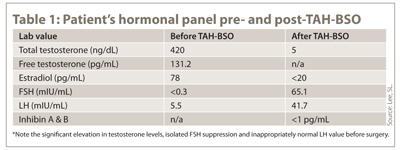Honduran woman with facial hirsutism, abdominal pain
Click Here to Manage Email Alerts
A 39-year-old Honduran woman — gravida 6, parity 6 — presented to the endocrine clinic with several weeks of worsening right lower quadrant pain and 6 months of amenorrhea.
Her only medical problem was poorly controlled hypertension treated with amlodipine 10 mg daily. Menarche occurred at age 15 years with chronic oligomenorrhea. She has a menstrual period every 2 to 3 months but was able to conceive easily.
Physical exam revealed a healthy 39-year-old woman with marked facial hirsutism and mild tenderness at right lower quadrant upon palpation. She had a mustache, side burns and chin hair that required daily shaving. She did not have abdominal striae, acanthosis nigricans or a dorsocervical fat pad. Pertinent lab findings demonstrated a suppressed follicle-stimulating hormone (FSH) and elevated total and free testosterone levels (Table 1). CT of the abdomen and pelvis revealed a multi-fibroid uterus with the presence of a complex cystic and solid right adnexal mass measuring 7 cm x 6 cm x 8 cm (Figure 1).

Stephanie L. Lee

Karen Choong
She underwent exploratory laparotomy. Frozen section of the ovarian mass confirmed the presence of an adult-type granulosa cell tumor. Her surgery was converted to an exploratory laparotomy and total abdominal hysterectomy and bilateral salpingo-oophorectomy (TAH-BSO), pelvic lymph node dissection, para-aortic lymph node dissection, appendectomy and omentectomy. Pathology confirmed an ovarian granulosa cell tumor. Her clinical course postoperatively was uneventful, and she was seen postoperatively at the endocrine clinic. After oophorectomy, she had appropriately low estrogen and testosterone levels with elevated FSH and luteinizing hormone (LH) levels (Table 1).

Figure 1. Coronal CT with contrast of the abdomen and pelvis revealed a multi-fibroid uterus with the presence of a 7 cm x 6 cm x 8 cm complex cystic and solid right ovarian mass.
Source: Stephanie L. Lee, MD, PhD, reprinted with permission.
A rare occurrence
Granulosa cell tumors (GCTs) develop from the ovarian stroma, a hormonally active component of the ovary. This tumor accounts for about 70% of all tumors in the ovarian sex-cord category. Granulosa cells are particularly rich in aromatase enzyme activity and can produce high levels of serum estrogen from androgens secreted by the adjacent theca cells. The resultant symptomatology from the elevated estrogen levels is dependent on the age at onset. Prepubertal girls typically present with sexual precocity, whereas women of childbearing age tend to experience menstrual irregularities such as oligomenorrhea or amenorrhea. If the granulosa tumor occurs in a postmenopausal woman, vaginal bleeding may be the initial presentation. Because GCTs tend to be hormone-secreting neoplasms, they are frequently detected early (International Federation of Gynecology and Obstetrics [FIGO] stage I; tumor limited to one ovary, no ascites and no tumor beyond ovarian capsule), with a favorable prognosis. However, GCTs are also known to have late recurrence decades later.

Ovarian granulosa cell tumors often present as large multi-located cystic masses described sonographically as smooth or septated and multilocular cystic masses. There is a continuum, and the cystic structure may present as a thin-walled, unilocular cystic mass to a thick-walled bunch of grapes. GCTs are well defined, solid-cystic masses with low attenuation on CT scan, whereas on MRI there are often signal changes consistent with hemorrhage. Our patient presented with virilizing signs comprising of amenorrhea, facial hirsutism and voice deepening; all of which are the most common presentation of an androgen-secreting tumor. Although the theca cell is generally thought to be the main producer of androgens, granulosa cells have been documented to be able to synthesize testosterone de novo.
Androgen-secreting GCTs are a rare occurrence. To date, there are approximately 33 cases of androgen-secreting adult-type GCTs that have been reported in the literature. Testosterone is the predominant hormone secreted in an androgen-secreting GCT, and this patient had normalization of her serum testosterone level after removal of her tumor. Age of occurrence is mostly in the third and fourth decade of life.
Signs and symptoms
It is intriguing to note that our patient presented with an elevated testosterone level, alongside an undetectable FSH but normal LH. Elevated levels of testosterone normally result in suppression of hypothalamic-pituitary-gonadal axis, leading to decreased FSH and LH levels. Her tumor contained inhibin by immunohistochemistry. Inhibins are a group of heterodimeric hormones secreted primarily by granulosa cells that selectively suppresses FSH secretion. These hormones are made up of a common alpha-subunit and either a beta-A (inhibin A) or a beta-B (inhibin B) subunit. Hypersecretion of inhibin B has been associated with GCTs and can be used as a tumor marker for tumor recurrence and management in inhibin-secreting ovarian tumors. Similar to this patient, there are several case reports of inhibin B-secreting GCTs causing isolated suppression of FSH levels with normal or elevated LH levels that have been documented.
In summary, GCTs are an uncommon ovarian neoplasm. These tumors tend to secrete a multitude of hormones. Physical findings depend on the amount and type of hormones secreted by these tumors. Although most GCTs over-secrete estrogen, these tumors can, on occasion, manufacture androgens and result in virilization. Therefore, recent onset of virilizing signs and presence of androgen excess requires an evaluation for both a neoplastic source in the adrenal cortex and ovary in a female.
References:
- Aiman J. Clin Obstet Gynecol. 1991;34:835-847.
- Ko SF. AJR Am J Roentgenol. 1999;172:1227-1233.
- Outwater EK. Ultrasound Obstet Gynecol. 2000;15:365-371.
For more information:
- Stephanie L. Lee, MD, PhD, is associate professor of medicine; associate chief, section of endocrinology, diabetes and nutrition; and associate professor of medicine at the Boston Medical Center. Karen Choong, MD, is a fellow in endocrinology. Disclosures: Lee reports no relevant financial disclosures. Choong reports no relevant financial disclosures.
